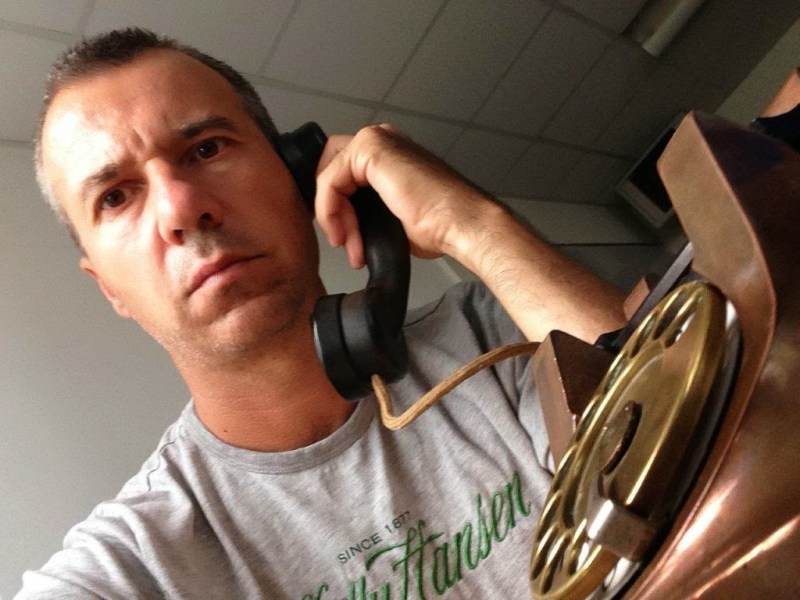[Ivan] is fed up with all this rampant virtualization. When his company took away his physical desk phone in favor of using MS Lync, he was driven to build a USB rotary phone. His coworkers loved it and one of them asked [Ivan] to build another. The build log focuses on converting his coworker’s vintage brass and copper number that must weigh a ton.
He had to do a bit more work with this one because it had rusted out inside and a few of the contacts were bent. The good news is that the speaker and microphone were in working order and he was able to use them both. After restoring the stock functionality, he added a USB sound card and created a USB keyboard using a PIC32MX440F256H.
The rotary phone’s dial works using two switches, one that’s open and one that’s closed when no one is dialing. Once dialing is detected, the open switch closes and the closed switch clicks according to the dialed digit (ten clicks for 0). [Ivan] also reads the switch hook state and has added debouncing. This gave him some trouble because of the quick response expected by the PC bus, but he made use of interrupts and was allowed to keep his seat.
Please stay on the line. [Ivan]’s videos will be with you shortly.
















Sounds only slightly more useful than the rotary phone shower I made: http://cassettepunk.com/small-projects/duchess/
‘Ten clicks for 0’
— Did you know New Zealand have a reverse layout – so 1 is 9 clicks. But 0 is still ten :-)
http://en.wikipedia.org/wiki/Rotary_dial
In Poland 0 was 1 click, 1 was 2 clicks, 9 was 10 clicks.
Didn’t know that New Zealand also have this layout ( 9, … 1, 0 ). About half of Oslo, Norway, have (or may be had) it. Think the other half have the international one: 1, … 9, 0 .
In Sweden we have: 0, 1, … 9 .
Remember from the market parameters in the PBX MD110 they were called something like: International, Sweden and Oslo-digit !
ha cool, i’m also building something like that but with bluetooth
You should check this page http://www.sqnewton.com
Sparkfun sold modified rotary phones (standalone cell and bluetooth) a while back. It is a fun concept. I bought one and had trouble getting it to work on my phone so I had to return it. Here’s the page on their site with info on how theirs worked. https://www.sparkfun.com/products/retired/286
Can you dial the phone by tapping on the hook switch like the old dial phones?
Maybe a Captain Crunch whistle will reveal the Easter egg.
LOL, I don’t think in-band signaling works anymore, but as recently as 2007 (last time I tried it), in Oklahoma, USA, pulse dialing still worked.
Inband signaling is a lot more common then you might think. The difference is it’s often sent over bit-robbed T-carrier. So instead of a 2600 wink, you’ll just hear a 1333 hz tone faintly in the background if you’re calling with something reasonably good. There’s lots of stuff like AISes, or certain LECs that can’t justify the cost/complexity of adding common channel signaling. 907-293 in Nikolai, Alaska is one such office. 0000 is a vacant number there.
Anyway, here’s an ANAC that accepts MF if you want to try your luck with it. Do note that after the call goes offhook, you will have to send your digits fairly loudly/cleanly; it is quite picky – +1-503-697-0053. It takes KP + 3 + (seven digits) + ST.
You can simulate the rotary mecanism by giving very short “clic” on the hanging mecanism, waiting a little between each figure… It was very practical some years ago, since the phone concentrator (don’t know the precise name in english) understand multitone and interrupts for numbering : this let you phone for free (albeit illegally) on some paying phones were you cannot use the digital keyboard without throwing some money in :-)
It was also handy for dialling phones without a dial, good for ordering pizza.
Some answering machines had a remote to use over pulse dial only phones. The remote was pre-programmed with the few DTMF codes needed to operate the machine.
That same remote was also available in a version with a full keypad and a memory for several numbers to speed dial.
What’s extra neat about such remotes and dialers is they still work, so if you find one of the programmable models you can have speed dial on *any phone*.
Bluetooth version
http://www.sqnewton.com
I think there might be a rather simple way to detect ringtone without having to add software: modify your sound file to include a particular tone at the beginning, then the real ring tone. The PIC can be used to run an FFT and detect the tone, once it detects it it plays the audio from the sound card through a speaker(or actually use a real mechanical ringer) and switches to the handset once you pick up. I am thinking a simple 2 tone DTMF should be easy to make as there are algorithms present.
I had one of the last real rotary pulse dial phones in service up until I moved about 7 years ago now. They wanted to bill me an extra dollar for touch tone, but I never went for it.